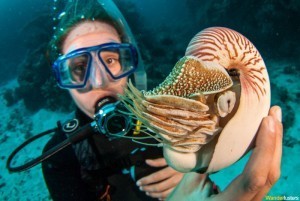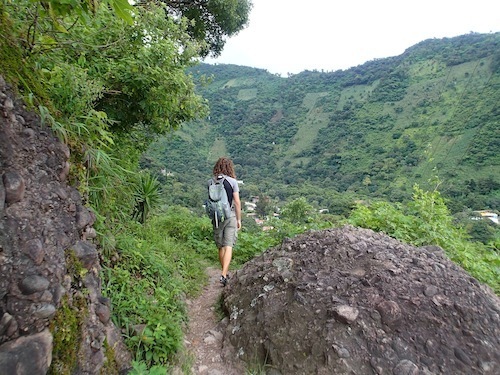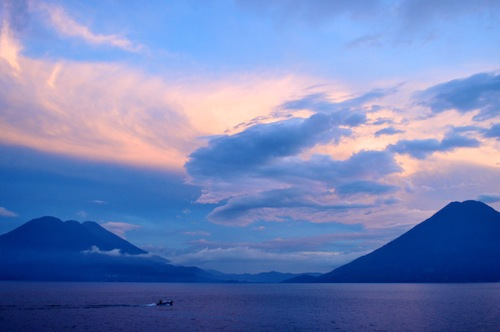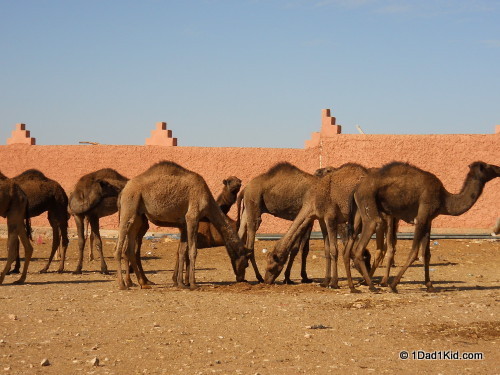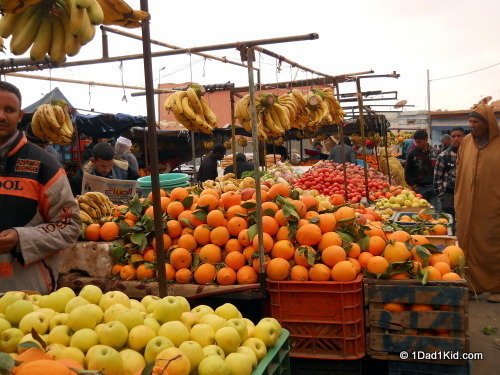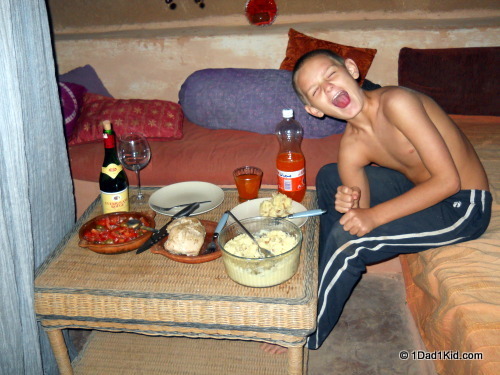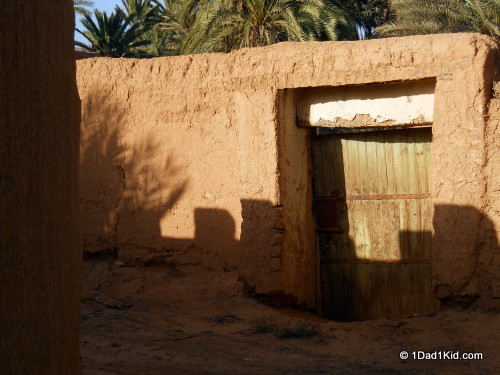Rolf Potts's Blog, page 45
March 27, 2014
Vagabonding Case Study: Wandertooth (Geoff and Katie Matthews)
Vagablogging :: Rolf Potts Vagabonding Blog
Geoff & Katie Matthews
www.wandertooth.com
Age:
Geoff: 37
Katie: 33
Hometown:
Geoff: Calgary, Alberta
Katie: Vancouver, BC
Quote:
Geoff’s favorite: “To live is to change, and to be perfect is to have changed often” by John Henry Newman.
Katie’s favorite: “Not all who wander are lost” by J. R. R. Tolkien. I also like the line before, “all that is gold does not glitter;” it is such a fitting way to look at difficult journeys.
How did you find out about Vagabonding, and how did you find it useful before and during the trip?
Rolph Potts is such a legendary traveler, so I suppose we found out about it through word of mouth. We’ve found it to be inspirational for us: when we were planning the trip, it was nice to know that there are other people out there like us. Now that we’re traveling, it’s helpful to know that people are able to maintain this lifestyle long term.
How long were you on the road?
When we met, we were living in Taiwan and both decided we wanted to live a life of travel. We spent 3 months in South America in 2010, and recently left on another trip: we’ve been on the road now for four months, with no plans to stop.
Where did you go?
On this current trip, we have been to Portugal and southern Spain. We are currently in Edinburgh, and our next stop is Romania.
What was your job or source of travel funding for this journey?
Immediately before leaving for this trip, we were living in Vancouver and both working in professional jobs. We moved into Katie’s mom’s house so we could save more, and put away about 80% of our income.
Did you work or volunteer on the road?
We are trying to. Katie has been working on Elance, and writes travel and career-focused articles for several websites. Geoff has been building up his video editing and filming skills. We are also working to build our travel blog and monetize it. We work much longer hours now than we did in Canada, and make far less money. However, we hope that if we stick with it, things will start to fall into place and we’ll be able to cover the costs of this lifestyle at minimum.
Of all the places you visited, which was your favorite?
Geoff: The Bolivian Salt flats are probably the most unique place I’ve been, and I have great memories of that trip.
Katie: Seville, Spain. I can’t say Seville is my favorite place ever, but right now it is my favorite. It is hard not to fall in love with the Spanish way of life, and Seville is such a beautiful city.
Was there a place that was your least favorite, or most disappointing, or most challenging?
Geoff: Bolivia. I had a terrible experience at a hospital in Bolivia, and got quite ill. We ended up having to stay in Sucre for several weeks until I was well enough to travel again.
Katie: I find I am most disappointed in places where I’ve built them up in my head prior to the visit, so now I try not to have too many expectations when visiting a place. The first time I visited Cambodia, I was disappointed for this reason. I’ve since been back, so obviously I got over my disappointment!
Which travel gear proved most useful? Least useful?
The least useful probably depends on the area. In South America, we had refillable water bottles, but never used them because the tap wasn’t always safe. However, in Europe, a refillable water bottle is awesome! We had travel towels, but ditched them because most places we stay have towels.
The most useful thing may be our sleep sacks – we don’t often use them, but when we need to, we are really thankful to have them.
What are the rewards of the vagabonding lifestyle?
It is really rewarding to be able to stay in places longer, and experience what every day life is like. In Portugal, we were house sitting for 7 weeks, and had to go to the grocery store and post office just like everyone else. We’ve been in Edinburgh for one month now, and haven’t even been in the castle.
That, and rarely having to set an alarm clock.
What are the challenges and sacrifices of the vagabonding lifestyle?
There are many. Probably the biggest one is about friends and family. We have real life and social media friends we get to visit around the world, and we’re able to keep up with friends from home using technology, but we don’t really have a social life to speak of, and have to entertain each other. We also miss out on family events; Katie’s brother is going to be a new father soon, and it’s sad to not be around for that. Also, financial uncertainty is wearing.
What lessons did you learn on the road?
There really is no reason to fear the world. People are nice. We were nervous about visiting Colombia, but people there are the same as people almost everywhere: they wake up, go to work, and go home to spend time with friends and family. People are friendly and helpful!
How did your personal definition of “vagabonding” develop over the course of the trip?
It’s hard work, and it takes commitment. We work longer hours now than we did in Canada, and I don’t know if we realized that would be the case before we left.
If there was one thing you could have told yourself before the trip, what would it be?
Save more money!
Any advice or tips for someone hoping to embark on a similar adventure?
Do it before it’s too late, and don’t believe people who tell you that you can’t do it. Even if you don’t have as much money as you think you need, you can still travel by finding work abroad.
When and where do you think you’ll take your next long-term journey?
This journey doesn’t have an end date, although if we run out of money, we’ll probably look for English-teaching jobs somewhere. We are going to Romania in April, and plan to spend four months traveling through the Balkans. Our next house sitting commitment is in Doha, Qatar in August, and after that we have no plans.
Read more about Geoff & Katie on their blog, Wandertooth or follow them on Facebook and Instagram.
Website: Wandertooth
Twitter: Wandertooth
Are you a Vagabonding reader planning, in the middle of, or returning from a journey? Would you like your travel blog or website to be featured on Vagabonding Case Studies? If so, drop us a line at casestudies@vagabonding.net and tell us a little about yourself.
Original article can be found here: Vagabonding Case Study: Wandertooth (Geoff and Katie Matthews)
March 26, 2014
7 things that will help you understand using travel rewards cards to your advantage
Vagablogging :: Rolf Potts Vagabonding Blog
From the very beginning of our travel together, my husband and I have done all of our international flying with frequent-flier-miles. With Asia and Easter Island both on our itinerary for our first gap-year of travel, crossing the distances we had in mind would have seemed financially impossible for us without frequent flier miles.
Perhaps there’s a misconception out there that you must first pay for a significant amount of flying before you can accumulate enough frequent-flier-miles for a free international flight. That may be true when using the traditional approach to earning miles. But there is another strategy that has become quite popular for earning miles that requires no flying at all.
Credit cards.
There are dozens of them. And of course, it can get quite confusing. So I’ve put together a list of 10 things to help you understand travel rewards cards, and therefore, use them to help you with your own travel goals.
1.) Not all cards advertised as “travel rewards cards” will earn you frequent flier miles.
There are basically four types of currencies you can earn with travel rewards cards: 1) frequent flier miles with a mileage program, 2) hotel points with a hotel rewards program, 3) points that can be transferred into frequent flier miles or hotel points, and 4) points that can be used to reimburse money you spend on travel.
The latter can be good for covering what frequent flier miles cannot, but won’t be as significant in earning you a free international flight.
2.) Just because a card is offering a bonus, it doesn’t mean it’s a good bonus.
All the major travel credit cards advertise mile or point bonuses. This is the main appeal in many cases however, it’s worthwhile to do some research when you see a card offering a bonus. For instance as mentioned above, there are various currencies in the travel rewards card world. Find out what an advertised bonus could realistically translate to in terms of travel.
Even once you have acquainted yourself with the bonus’ currency, it’s also good to know the difference between a good bonus and a weak bonus. At least when it comes to miles, hotel points, or points that can be transferred into miles, we generally tell people that 50,000 points is a good bonus.
3.) There are often requirements you must reach before you earn the bonus.
Occasionally a card will offer a bonus that you can receive as soon as you sign up or make your first purchase. But more often there is a spend-requirement you must reach first. Generally it’s set anywhere from $1,000-$10,000 spent within the first 3-6 months depending on the card.
Many cards offer bill-pay set-ups online to help you work towards that spend-requirement with your ordinary spending.
In the travel-hacking community however, it has become quite popular to use your credit card to purchase something that can easily be turned back into useable cash. Gift cards for example have paved the way for a cheap though admittedly complicated strategy for reaching spend requirements.
4.) Many cards also have an annual fee, though sometimes it’s waived for the first year.
It’s up to you how to handle this annual fee. Sometimes the card’s regular earnings from ordinary spending, annual gifts, or other card perks are enough for the annual fee to be worth it. That is up to you but you should understand that canceling a card after just a year can have an effect (albeit a fairly small one) on your credit score.
Your credit score takes your average length of history into account and having multiple 1-year accounts will lower that average. Because of this, we recommend having a few no annual fee cards that you will keep, even if you never use them. We also recommend that, if a person doesn’t feel they can keep up with the annual fee (or doesn’t wish to), they try having the card downgraded to a no-annual fee card after the first year.
5.) Collecting miles with credit-cards has a lot to do with credit score.
Most of the good travel cards require you to have at least a fair credit-score for approval. You can get a free credit score estimate with sites like Credit Sesame or Credit Karma. Technically they are just estimates, but they tend to be pretty close to accurate.
6.) Having multiple credit cards can actually improve your credit score.
Credit score works a little differently than many people may assume. It is less a measure of your financial status, and more a measure of your ability to be responsible with debt. It’s all about debt management really.
Therefore, the more cards you are responsible with, the higher your score will be. We have tested this and seen it to be true, as have many others.
Of course, the most important point here is that being responsible with multiple cards has a good effect. Being irresponsible with multiple cards could be very dangerous.
You can read more about what responsible credit card use is in our post about how credit score and travel-hacking work.
7.) Applying for cards too closely together will prevent you from getting approved.
Applying for one card today and another one tomorrow will make you look desperate and will prevent you from getting approved for a card, even if your credit score is great. If there are multiple rewards cards you’re interested in, wait at least 3 months between each application. Some suggest you don’t need to wait that long, but this is the safer strategy.
Credit cards are a huge part of the travel-hacking budget strategy and these 7 things will give you a place to start your research. Ultimately, the idea here is that rewards cards are helping you and that you’re in control of them, not the other way around. While trial and error is certainly a part of everything in life, especially when it comes to credit and credit cards, it’s good to be as informed as possible from the beginning.
Original article can be found here: 7 things that will help you understand using travel rewards cards to your advantage
March 25, 2014
Field Report: Ayres Rock – The beauty and the culture of the red centre
Vagablogging :: Rolf Potts Vagabonding Blog
A big red rock, Kangaroo Dancing, Thorny Lizards and beautiful sunsets
Cost/day:
In our fist 3 day stay at Ayres Rock Resort we must have spent about $30 a day, give or take, on food and drink. This however doesn’t include the $25 for a 3 day pass to the Uluru National Park or the $72 we paid for the first 3 night stay on the campground. If $72 sounds affordable that’s because it is but we were lucky to have gone at the end of the winter season. This is when the resort offer 3 nights for the price if 2 on camping pitches.
What’s the strangest thing you’ve seen lately?
Have you ever seen a Thorny Devil? A lizard with spikes all over its body. It’s harmless and if you get near, it stands still hoping not to be seen. The friendly lizard absorbs water from its feet to it’s spikes across the top of its back for consumption. If you were to pick one up and place it on your arm you’ll feel the suction on your skin. They are cute but a bizarre looking reptile.
Describe a typical day:
all activities on the site are included in the price. I would wake up and cook some poached eggs on toast from the camp kitchen. Catch up on some daily news with a coffee. I like to write before midday, an hour putting pen to paper. Get washed and ready and stroll into the town centre. A great indigenous man named Leroy can take you through some bush yarns (stories) about male and female roles in a mob (tribe/family) and talk you through aboriginal weapons and hunting equipment. He is a really interesting man and will happily spend time after to answer any questions you have. I don’t think I quizzed him once without getting a thorough answer – a very knowledgable man.
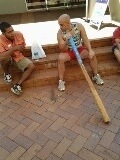
Soon after weapons it’s time for Udarki (didgeridoo) playing with the Aboriginal Wakagetti team. Again some really great, wise, friendly people who take pride and enjoyment in their work. Be aware that the Didgeridoo is regarded as a mans duty amongst certain aboriginal folk. I loved this as it’s the first time someone has taught me how to really play the instrument unlike my raspberry blowing I did at school!
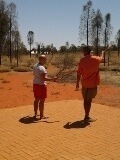
Once finished its time to make my way to spear and boomerang throwing. This is a great deal of fun, hosted again by the Wakagetti team. Yet another great way to learn some really intriguing facts about aboriginal hunting. If you’re good at the boomerang throwing it is often advisable to duck, they come back fast! It is very enjoyable to watch all other participants climbing over themselves to escape the incoming missile!
Lunch time would be spent at the Kulata Deli where the best sandwiches are made by the resorts indigenous training team. We loved the sandwiches here, my favourite being a turkey and bacon grilled panini stacked with all the salad. This is more than enough to fill this hungry little man!
After lunch it’s a cool down with a swim in the campground’s pool and catch up on my tan. I was looking vaguely like Casper the ghost before I set out in this journey!
After chilling out I would head back into town to take part in the Wakagetti Indigenous dancing. They offer a tutorial taking you through various aboriginal dances. This is then followed up with a fantastic performance from the team exhibiting genuine cultural dancing. I couldn’t resist finding myself up on stage to show my best Kangaroo dance – a great deal of fun.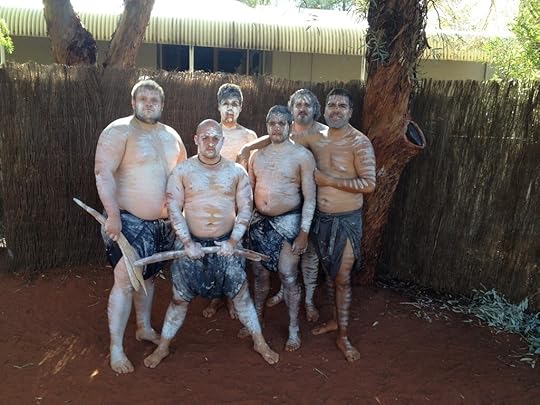
Then it’s getting time to drive out to the Rock’s viewing point to watch a magnificent sunset over Uluru. This cannot be missed in my opinion – it is a far better sight to behold than a sunrise. If for any reason it’s a cloudy day don’t be down hearted, the most beautiful colours light up the sky and add an array of beauty to an already magnificent view. It can also be a very romantic setting where a cuddle or two can be shared.
Back to camp kitchen for goon (cheap cask wine) and food, typically a barbecue and to converse with the hive of travellers that congregate around the barbecue. Then it’s time for bed. Word of warning – try to hold back on the wine if your planning a sunrise trip because it can be a very early start.
Describe an interesting conversation you had with a local:
The most interesting conversation I had was with a local who worked out of the brilliant Uluru Cultural Centre. When I used to imagine an aboriginal person, I would see a tribal black man. The conversation allowed me to learn that Aboriginal or Indigenous people are not this typical stereotype we often see in books, TV etc. What I came to understand is there are a variety of colours amongst mobs and I was asked to understand that to be an aboriginal man is about being close to the culture you were raised in, to understand and love your upbringing and engage and learn the knowledge and stories of your elders.
I am ever inquisitive and we spoke for quite some time on this subject. I realised that I had a misguided representation of just what it means to be aboriginal. This is often overlooked and can still be misinterpreted.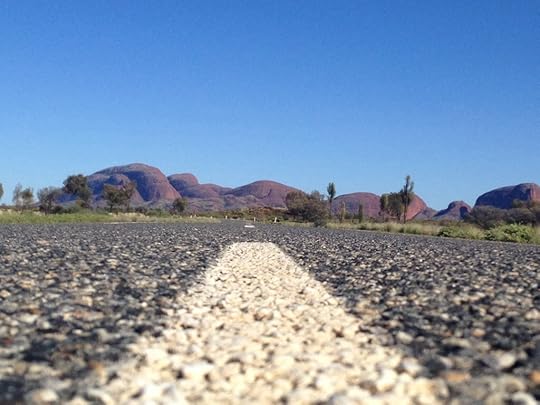
What do you like about where you are? Dislike?
I love the beauty of the surroundings. The desert is fresh and untouched. This is where millions of years of nature continues to thrive. The red sandy plains reflect the years of natural formation of its beautiful vast landscape. I am yet to find a place that has such varying beauty. The changing skylines give various backdrops to fantastic desert views. There are many beautiful sunsets to be experienced watching the skies light up night after night with the most vibrant reds, purples and oranges. In contrast to this is the powerful lightening storms that can occur. Large thunderous clouds sweeping the skies, lighting up the desert for miles around, often silhouetting Uluru on the horizon. The clear nights offer you a chance to gaze upon the starry cosmos. This leaves you with the euphoric feeling that we as humans on this planet really are just floating on a rock in the large nothingness of space.
I would enjoy watching many creatures that live amongst the bush lands. From the suspicious dingoes to a wondering thorny devil. The trees filled with Brolgas and Magpies to the Goannas that plod along on the land below. Moths the size of your hand, to the angry little Praying Mantis who would offer you a fist fight if you came too close. It is fantastic how all the elements here live and breathe together as one, each knowing there own place in the world.
The only thing I would say I disliked is the endless repetitiveness of the journey here. It is a long drive with very little in between and when your van was as rickety as our van was, you often imagine being stranded in the middle of no where. However I would do it all over again for a chance to relive this experience.
Describe a challenge you faced:
the biggest challenge we faced was the distance from anywhere. The van was in good condition for a motor of its age. The driving hours are long whichever route you take.
What new lesson did you learn?
Being here in the red centre allowed me to understand a very significant part of my English history. As an Englishman I felt ashamed by what had been done to the natives of the land. I was able to grasp a true understanding of what culture, friendship and respect really means. The strength of belief and companionship, the pride of knowledge, what it means to be alive and treating the world around you with respect. I learnt to be at peace with the world. I have found out a lot about myself in my time here. These are lessons and understandings that have helped me as an individual understand what is important in life and what we often miss in the modern western world.
Where next?
It’s off to Sydney!
Original article can be found here: Field Report: Ayres Rock – The beauty and the culture of the red centre
March 24, 2014
Vagabonding Book Club: Chapter two: Earn your freedom
Vagablogging :: Rolf Potts Vagabonding Blog
An excerpt from Chapter Two: Earn Your Freedom: Vagabonding: An Uncommon Guide to the Art of Long-Term World Travel, by Rolf Potts
“Vagabonding is about gaining the courage to loosen your grip on the so called certainties of the world. Vagabonding is about refusing to exile travel to some other, seemingly more appropriate, time of your life. Vagabonding is about taking control of your circumstances instead of passively waiting for them to decide your fate.
Thus, the questions of how and when to start vagabonding is not really a question at all. Vagabonding starts now. Even if the practical reality of travel is still months or years away, vagabonding begins the moment you stop making excuses, start saving money, and begin to look at maps with the narcotic tingle of possibility. From here, the reality of vagabonding comes into sharper focus as you adjust your worldview and begin to embrace the exhilarating uncertainty that true travel promises.
In this way, vagabonding is not merely a ritual of getting immunizations and packing suitcases. Rather, it’s the ongoing practice of looking and learning, of facing fears and altering habits, of cultivating a new fascination with people and places…”
If there was one lesson that I wish could be downloaded to the heart and mind of every newbie traveler, this would be it: That it’s the decision to vagabond that changes everything, not the geographical diversity.
For most people, their actual “trip” is measured in months, or perhaps a couple of years at most. It’s time bought back by periods of dedicated work and frugal living. But the changes that vagabonding works in a person’s outlook and underlying philosophy carry over into “daily life” upon their “return.” I was talking to my Dad about this recently. He turns 70 this year and if you look up “vagabond” in the dictionary, you’ll find his photo next to the definition. “Someone asked me recently about when I was taking my next trip,” he mused, “It took me a minute to answer… I was confused… there’s a ‘next trip?’… it’s all one big trip to me, and I’m still on it!”
That’s the essence of it, really. You take off on your first trip at twenty four and forty-five years later you’re still on the road, in your heart and mind as much as in the physical sense.
I have a friend who is turning forty this year. When we were 15, she was the one reading Jack Kerouac in the lunch room and lamenting that she’d was born into the wrong decade. Travel, vagabonding, were in her soul, and yet, she has never traveled. She called me about a year and a half ago. I was bussing around Southeast Asia a the time. She asked me if I’d be up for walking the Camino de Santiago with her this summer. Of course, you know my answer. It took a lot of ramping up for her to make the decision to go, to ask me to be her companion for the walk, and to commit to doing the thing she’s been dreaming of since we were children. That’s not a small thing. You know what I’ve noticed? From that moment on the phone between continents, she’s a different person. She is a vagabond. She’s earned her freedom in every sense. Her victory will feel sweet when that plane lifts off in a few weeks, but that isn’t the moment that her trip begins. It began a year and a half ago, with her commitment, and it’s just the first step of a journey that will last for the rest of her life.
So, what do you think? What are your reflections on chapter two? How has the concept of vagabonding changed how you experience life at home and on the road? How have you earned your freedom?
Original article can be found here: Vagabonding Book Club: Chapter two: Earn your freedom
March 23, 2014
Travel is an implicit search for difference
Vagablogging :: Rolf Potts Vagabonding Blog
“We board our jumbo jets precisely to find a world where there are no jumbo jets. We pass through security to get to a land where there is no more need to do so. We look for Elysium in distant lands where there are no hamburger stands and satellite dishes and telephones — and yet all the while men have come before us and built and installed precisely those things that we were hoping to get away from, and have made where we are going just a little more like where we have just come from. So in eternally frustrated hope that somewhere, some God-given somewhere, there is a world without mini-bars and IDD and Visa and, most of all, CNN, we move onward, ever onward, like caribou, like lemmings.”
–Simon Winchester, intro to Martin Parr’s Small World (1995)
(1995)
Original article can be found here: Travel is an implicit search for difference
March 22, 2014
Preparing to hike the Salkantay Trek to Machu Picchu
Vagablogging :: Rolf Potts Vagabonding Blog
I am writing from my sleeping bag in the Lima airport, getting ready to go to “bed” for the night on the food court floor. Today starts my two week trip to Peru, and I have an early flight to Cusco in the morning. In some ways I feel prepared (for instance right now I have a sleeping bag, ear plugs, and eye mask, while I see other struggling to sleep/fight sleep at food court tables), but in most ways I feel very unprepared for this trip. It was a spontaneous decision that myself and two girlfriends made just a few months ago, after finding ourselves on the same continent for the first time in over a year. Why not fly halfway around the world and hike Machu Picchu? I think a good bit of planning could have happened if we had really put our minds to it, but instead this will be an account of travel “winging it.”
It seems that the more I travel, the less I prepare. This is good in some ways, but of course could result in some major inconveniences. When I first left for a round-the-world trip in March of 2012, all I could think about for months in advance was plan, plan, planning. I even committed to the decision to save money and leave everything behind a full year in advance. Today, I find myself running to my flight as they are paging my name, only vaguely knowing the name of the hotel I am staying, not knowing the exchange rate for the country I’m visiting, etc.
Here is a photo of the things I packed before I left in 2012:
Here is a photo of my preparation for this trip:

This picture is a good representation of my current attention to detail in planning. Not at the top of my game, and maybe not completely recommended, but also not completely detrimental to a trip. Sometimes you just have to jump in without a plan.
Thanks to some internet research we came to the conclusion that a few basic tasks were necessary prior to arriving in Peru: booking a specific trek with a tour company due to limited availability, booking some basic internal flights before the price jumped, and knowing where to find the llamas (apparently they are quite bountiful). Some trips to our favorite outdoor clothing stores fitted us with sturdy boots, warm gloves, and plenty of layers for the high altitude weather. We used the company Cuscoperuviajes for our Salkantay trek. They were a bit cheaper than a lot of the other companies out there, and the reviews we saw were positive.
And the plan is to meet in Cusco.
I have a unique situation where I absolutely completely loathe flying, every single time. Unfortunately it doesn’t get better with experience. I also get anxiety and motion sickness on fast moving buses, and the thought of altitude sickness stresses me out. It’s not easy to want to travel so often but to be so scared of your means to do so. Sometimes you find yourself thrown into a situation by no one other than yourself, only to love and hate it at the same time. You might find yourself on a plane to get to the one place you’ve always wanted to go, only to wish you could call the whole thing off to escape the sudden onset of rough turbulence at 35,000 feet in the air. Climbing a mountain for four days to get to a World Heritage Site sounds like a great idea until you realize you aren’t really in shape for it and that you may suffer from altitude sickness and will be forced to ride on a disgruntled donkey along the edge of a cliff for hours on end. Travel has a way of pulling out the very best and worst of you, the most adventurous and the most fearful parts. But, you do it because you get something more out of it. You learn to depend on yourself in ways that you never thought you were capable. You have a new appreciation for where you are from, or maybe you find that you belong somewhere else. You meet people that inspire you to embrace life and adventure that you would have otherwise never met. Travel is one of the most enriching things you can do for yourself, and hopefully the people around you.
So all that said, here I am, waiting for an early flight, pushing all the anxiety I have to the bottom of my thoughts, and thinking about the positives. The photos I will take, the physical challenges I will overcome, and the new foods I will try. I’m thankful for my equally spontaneous friends and the chance to go see a new country and culture. Assuming I make it out alive, I’ll be back with an update on how it all went.
Has anyone else been to Cusco or hiked the Salkantay? Any advice on what not to miss or important things to pack would be welcomed!
Original article can be found here: Preparing to hike the Salkantay Trek to Machu Picchu
March 21, 2014
Must I get “Off The Beaten Path” when I travel?
Vagablogging :: Rolf Potts Vagabonding Blog
I’m a big advocate of getting off the beaten path, but I would agree that there’s nothing wrong with the attractions of the “tourist trail.” These standard attractions—from Machu Picchu and Angkor Wat right on down to small-town museums and curiosities—are part of what inspires people to travel in the first place.
So why do salty travelers tend to prefer roads less traveled to the tourist trail? I think there are two main reasons. First, big tourist attractions (naturally) attract lots of tourists, which can make these places feel overcrowded, inauthentic and only tenuously connected to the host culture. Second, major tourist sights tend to be the default activity when you are traveling too quickly or unimaginatively to truly experience a place. Instead of trying to see, say, the Colosseum, St. Mark’s Square and the Uffizi Gallery over the course of four days in Italy, I’ve found it more enjoyable to just stay put in Rome (or Venice, or Florence) for all four of those days and mix in some spontaneous, unconventional experiences with the obvious local attractions.
Even if you do find yourself in the midst of a huge crowd when visiting the Acropolis or Uluru or Iguazu Falls, it’s good to be respectful of the individuals around you, since a given tourist crowd can hold its own dynamic and diversity. One of my favorite books of recent memory was Sherman Alexie’s “The Absolutely True Diary of a Part-Time Indian,” which tells the story of Junior, a poor Spokane Indian kid living in Washington. Junior dreams of visiting the Great Wall of China, and one of the more moving scenes in the book is when his best friend Rowdy realizes that Junior is actually going to do it someday.
This is the kind of story I want keep in mind should I ever go to, say, the popular Badaling section of the Great Wall near Beijing and find myself in a sea of tourists. At one level, dealing with a big crowd of people might feel distracting, but at another level it can be humbling to realize that many of those people may well be in the midst of the most amazing experience of their lives.
Excerpted from Ask Rolf on World Hum
Original article can be found here: Must I get “Off The Beaten Path” when I travel?
Vagabonding Case Study: Charli Moore
Vagablogging :: Rolf Potts Vagabonding Blog
Charli Moore
Age: 26
Hometown: Norwich, United Kingdom
Quote: “There’s nothing you can’t overcome if your desire to achieve is strong enough.”
How did you find out about Vagabonding, and how did you find it useful before and during the trip?
I first came across Vagabonding in 2010. I’d not long graduated University and had thrown myself into an unpaid internship in London.
Working long hours for little financial reward I, like so many graduates, lived in hope that my efforts and experience in the field would be rewarded with employment.
I was one of the lucky ones. Not only did I land an internship with one of the leading arts organizations in London, I was offered a job at the end of it.
Then just 14 months later, I quit.
I didn’t quit for any other reason than the simple fact I wanted more, more from my existence.
For a number of years my partner and I had spoken of our desire to travel, and while he had supported me in my decision to get a foot up on the career ladder, we both knew that a period of travel was something we wanted.
However at that point, travel was something we couldn’t necessarily find the time to achieve.
6 months into my first job I read the phrase, ‘Anyone with an adventurous spirit can achieve the feat of taking extended time off from work to experience the world.’ After reading Vagabonding cover to cover I knew that our dream of travel was achievable, all we had to do was make it happen.
How long were you on the road?
We flew out of Heathrow Airport on 1st June 2011 and we’ve yet to return.
Where did you go?
The first 6 months of our travels were spent predominantly in Costa Rica, although we spent week here and there in Toronto, Chicago and Granada, Nicaragua.
We utilize house sitting assignments to subsidize our cost of living and so tend to allow our itinerary to be dictated by the opportunities we are offered.
Securing an assignment in Vancouver we made the transition from the warmth of the tropics to the frigid winter of British Colombia, and took the opportunity to hone our snowboarding skills.
Seattle and Hawaii offered stepping stones for our journey over to Australia. There we activated working holiday visas and spent the following 12 months on an epic road trip which would see us almost circumnavigate the vast red continent.
As I type these words I’m sat in a campsite in New Zealand’s Abel Tasman National Park. The last 13 months have offered us the opportunity to hit the road once more, this time to explore the landscapes of Australia’s indomitable neighbor.
What was your job or source of travel funding for this journey?
Before leaving home I worked as a PA in the London arts scene, and my other half worked in IT for a large multi-national.
Did you work or volunteer on the road?
We’ve both held working holiday visas for a large part of our travels to date and so have managed to pick up freelance work as we travelled around on our road trips.
Now that travel has become an integral part of our existence, we’ve started to look for ways to source a regular income on the road.
Of all the places you visited, which was your favorite?
We both fell in love with the lush landscapes and laid back vibe of southern Costa Rica. Our house sitting assignment in the region opened our eyes to the joys of simple living and we became quite adept at living off the grid.
Having said that, New Zealand is currently taking strides towards the #1 spot. I’m constantly in a state of awe; each new location we visit offers insight into Mother Nature’s phenomenal creativity.
Was there a place that was your least favorite, or most disappointing, or most challenging?
I’m not sure that anywhere we’ve travelled has been disappointing; to me a new location has merit simply because I’ve yet to explore its landscapes and understand its cultures.
Which travel gear proved most useful? Least useful?
I keep two travel sporks in my purse at all times. I’ve used them on planes, in cafes and on the streets of every country we’ve visited.
I’m sad to say least useful has been our Pack Safe. A metal mesh bag that is designed to secure a backpack and prevent theft, it has seen the light of day only twice.
What are the rewards of the vagabonding lifestyle?
Freedom and enrichment.
My vagabonding lifestyle offers me the freedom to explore the world on my own terms. I’m not bound by annual leave or the constraints of a package holiday. I can experience the locations I visit as I choose.
My travels enrich my life, there’s really no other way to describe it. I’ve found that I’ve received an entirely new form of education since leaving home. I’m grateful for the opportunities I have and thankful I have found myself with the freedom to travel.
What are the challenges and sacrifices of the vagabonding lifestyle?
Despite the many positive aspects of perpetual travel, there are two things of which I am conscious my vagabonding life does not promote.
The first is relationships. I am blessed to have such a wonderful travel buddy in my partner Ben, however we do not have a social network of friends and family whom we see regularly. Our friendships are made in passing, and while many are built with strong bonds we know that they may only result in infrequent conversations from across oceans and continents.
The second is stability. Unlike many of our peers we are not working hard to invest in property, we have no plans to start a family just yet and our career ladder looks entirely different to that of those with whom we graduated.
We’re on a different trajectory to most, but in our eyes it is one enriched with experiences and understanding.
What lessons did you learn on the road?
I’ve learnt a lot about the person I am. Long term travel provides challenges that a daily 9 to 5 routine does not, and so it offers the opportunity to test limits and push through barriers.
The last 3 years have taught me I’ve a lot more passion, understanding and strength than I had previously thought.
How did your personal definition of “vagabonding” develop over the course of the trip?
The concept of vagabonding has become a constant in my life. No longer is it just a term that defines an inaccessible lifestyle, it is now something that inspires me to strive to achieve my goals.
If there was one thing you could have told yourself before the trip, what would it be?
That travel would enrich my life more than my previous 23 years of education, so why had I not already booked a flight and crammed my life into a backpack.
Any advice or tips for someone hoping to embark on a similar adventure?
There’s nothing you can’t overcome if your desire to achieve is strong enough. Whether it be escaping your 9 to 5 or relinquishing the ties to what is considered as normality, there will be elements of long term travel that seem unobtainable.
Believe me, in 12 months time you’ll look back at the person who waved goodbye to the life they knew and you’ll thank them for having the strength to follow their dream.
When and where do you think you’ll take your next long-term journey?
We plan to continue our New Zealand road trip until our visa expires later this year. From here we’ll fly to the USA to take up a house sitting assignment and then … who knows.
Read more about their insatiable wanderlust on their blog, Wanderlusters or follow them on Facebook and Instagram.
Website: url.com
Twitter: handle
Are you a Vagabonding reader planning, in the middle of, or returning from a journey? Would you like your travel blog or website to be featured on Vagabonding Case Studies? If so, drop us a line at casestudies@vagabonding.net and tell us a little about yourself.
Original article can be found here: Vagabonding Case Study: Charli Moore
March 19, 2014
Getting robbed and questioning connectedness
Vagablogging :: Rolf Potts Vagabonding Blog
We turned the corner on the path and my heart immediately dropped. We had seen this man before. He passed us a while back, while we were taking pictures of our idyllic setting. Now here he was, standing amongst the corn, looking out over the lake, and waiting- for us. I knew something wasn’t right and I froze.
He mumbled one word: “dinero.” Aaron looked to me for a translation, not believing what was happening. “He wants your money”, I said simply. “Money, rapido!”, the man said. I registered, not for the first time, the machete in his hand, hanging at his side.
Everything I believe about people, about our connectedness, started to waiver and all I could see was that machete.
Aaron handed over his wallet and threw his hands up. I stayed frozen. I was hyper aware of every move, sound, and feeling but I did not move. The man approached me and I instinctively threw my hands up as well. He took the money out of my pocket, the machete still at his side, and ran off as soon as Aaron made a move towards us.
I exhaled and we took off. We practically ran over the thin path to the next town. Both of us were shaken and afraid that the man who had robbed us on a cloudy day on Lake Atitlan would follow us. He didn’t. He ran as fast in one direction as we ran in the other.
We felt angry, scared, and confused. Where did our beliefs about people fit into all of this? Where did our deep convictions on connectedness and the basic goodness of all people come into play? What exactly had just happened? We weren’t just robbed, it was as if our inner most thoughts had been exposed, challenged, and proven false.
We found a local cafe where we could re-group and I pulled my computer out of my backpack to work….. and stopped.
I had my computer, the one I had been carrying in my very visible backpack in an effort to search out a better internet connection in town. My camera, the same one the man who had robbed us had seen us using, was still dangling out of Aaron’s pocket. My wallet, holding an emergency 100 quetzales, was still floating around Aaron’s backpack. In fact, everything we had brought on our hike was still with us- minus the cash from our pockets.
I started replaying the event in my head. Thirty minutes ago I had been frozen in place focused on a man and a machete. Now I went back over the scene in my mind. He never raised his machete, in fact he seemed to forget he even had one, using his finger to point at us for emphasis. He never touched our backpacks; never reached for the camera whose red strap hand glaringly out of Aaron’s pocket. He never demanded more, accepting what was thrown easily in his direction. And when it was over, he ran. He ran as fast as we did.
Clarity started to overtake Aaron and I. We had just been robbed by a desperate man, likely out of work at the end of rainy season, not a career criminal. We had known enough to be grateful for our safety seconds after the attack, but what had eluded us in those first moments of escape was clarity and the ability to apply our connectedness with the man who had robbed us.
We will never know who that man was. We will never know his story or what ultimately led him to decide to wait for us on that path. What we do know, without a doubt, is that he never intended to hurt us- he just needed money. And ultimately, he needed that money more than us.
Understanding that even good people do questionable things when their backs are against a wall is a difficult lesson to internalize. The moment someone harms us, invades the sanctity of our space, or challenges our convictions, fear takes over and our instinctual response is to protect ourselves, physically, mentally, and emotionally. We make enemies out of men, turn the characters of the story into monsters, and delve into a realm of moral superiority that serves us in that moment. It separates “us” from “them”. It makes us feel better when we decide that the one who just attacked us or offended us was simply “bad”.
But what if the attackers aren’t “bad”? What if they are men and women with their backs against the wall and a family to feed? What if they are as scared of what they just did as the victims are? What if, in some situations, a closer examination blurs the line between “attacker” and “victim”? It’s an uncomfortable thought because it challenges the stories we create to protect ourselves. It also means that there might just be a day when that wall pushes against our own back and we do something we never thought we’d do.
There’s no way around it, getting robbed is no fun. But if travel has taught me anything it’s that our beliefs and our convictions cannot truly exist if they are never challenged and that every single situation, the good and the bad, are the puzzle pieces that make up the whole beautiful journey.
Travel is not always pretty. Neither is life in general. It’s the moments of clarity, sandwiched between the exceptional and the horrible, that make you think, for a moment or maybe more, that we are all just human beings at the end of the day and that we are all, truly, connected.
What might change and what might we gain if we stopped separating ourselves into “us” and “them” and started recognizing the common humanity we all share?
Original article can be found here: Getting robbed and questioning connectedness
March 18, 2014
Vagabonding Field Report: The Morocco most people won’t see
Vagablogging :: Rolf Potts Vagabonding Blog
Welcome to Guelmim, Morocco, the gateway to the Sahara!Cost/day: ~$24
What’s the strangest thing you’ve seen lately?
Camel meat is a common ingredient in the southern area of Morocco. There are 3 types of camel, and each color has its own function. White camels are special as they can smell water from 30 km. Dark brown (referred to as black) camels are used for work, and the lighter brown ones are used for meat. When you visit a butcher to buy your camel meat, you will find their legs hanging up. Younger camels are used for chops while older ones are more suitable for ground meat. It can be a little disconcerting to see a bunch of legs hanging in the air.
Describe a typical day:
Guelmim, admittedly, doesn’t have a lot of tourist activities. It’s best for those who wish to experience rural Morocco, a slice of life they will never experience in the more commonly visited cities of Marrkech, Fez, Casablanca, etc. However, it is easy to arrange a Bedouin experience in the desert from here. Guelmim is also within easy reach of some great beaches that are not overcrowded and packed full of tourists.
We enjoyed getting breakfast from our favorite cafe (ask for kulshi) and watching the world go by, which is a national hobby. Sip on your wonderful mint tea and savor the ritual that comes along with preparing it. Dip your pieces of bread in the wonderful argan (it tastes like almond butter) until your eggs come out on a sizzling platter. Rip off a piece of bread and use that and a finger to scoop up some egg. It’s a delightful way to begin a leisurely morning.
And no one does leisurely quite as well as the Moroccans.
Supermarkets do not sell fresh foods, so to get supplies you’ll need to visit a few vendors. Spend any amount of time here, and you’ll soon have your favorite vendor for produce, meat, chicken, bread, and so on.
Describe an interesting conversation you had with a local:
One of my fondest memories of our time on the nearby oasis was sitting down and chatting with a local about a number of things, one of which included attitudes about dress for women. It was a discussion that really challenged my way of thinking in a way I had not anticipated. It really forced me to reconsider my judgments regarding how women dress there.
What do you like about where you are? Dislike?
I loved the slow pace of life. It was really fun building relationships with all my regular vendors. Whenever I went into town unaccompanied by son, they would always inquire after him. It was easy to feel like you were part of the community, even if my French was limited and I only knew 4 words of Moroccan Arabic, 3 of which had been taught to me by our favorite bread vendor. He was a wizened man who always had a big, mostly toothless smile and who delighted in hearing me use the words he taught me.
I was not a fan of the mini buses and shared taxis. I don’t enjoy being squished into vehicles.
Describe a challenge you faced:
Communication was the biggest challenge. English is not commonly spoken. In fact, I found more people who spoke Spanish than ones who knew more than “Hello!” in English. My French was pretty limited, and many of the locals didn’t speak that language either. But they were never impatient. We always figured out how to communicate, and when we finally figured out what the other was saying, we would both laugh heartily.
What new lesson did you learn?
Never make snap judgments about a cultural norm. You don’t really know what’s behind it, and once you discover the history and its meaning it may not seem so strange, unusual, or awful as you initially thought.
Where next?
London! I can hear my bank account crying already.
You can follow along or learn more about our adventures on our blog and by connecting with us via Facebook.
Original article can be found here: Vagabonding Field Report: The Morocco most people won’t see
Rolf Potts's Blog
- Rolf Potts's profile
- 323 followers





